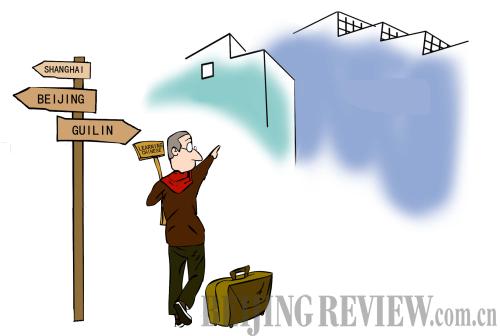|
 |
|
(LI SHIGONG) |
For those of us who have gathered the proper willpower to take that first step on the road to Chinese language fluency, a commonality is shared. We are a brotherhood. A sisterhood. A peoplehood of the abstractly motivated and outstandingly unusual. Learning Chinese is a boom and bust cycle of emotional victories and defeats, passion and depression. And it's a road with no end.
There's no secret to learning Chinese. It's an uphill battle. It's mostly a matter of finding the time to memorize words and characters, and maintaining the will to keep at it.
Why do we do it? Because it's a challenge. And because we have the foresight and the faith to know that fluency in Mandarin Chinese will open doors for us that we would otherwise puzzle over from a distance, forever wondering what might lie behind.
Whether we use our language skills to travel without fear of the unknown, to explore cross-cultural employment, or to read a Chinese book in the subway to impress whoever might be around, the benefits of the tortuous study of Chinese are many.
But the "how" of it all is perhaps the most daunting question. Fortunately, the answer is simple: Go to China. Where in China? In my experience, there's a trifecta of idealness that makes up the perfect language-learning environment.
First, avoid major international hubs like Beijing or Shanghai. China's big cities are certainly vibrant and interesting places, but the ubiquity of Western comforts can get in the way of language and cultural immersion. Many neighborhoods in China's urban centers are so saturated with international English speakers that it can sometimes be difficult to speak Chinese in a practical way. Many Chinese urbanites also speak at least a minimum of English, and many signs appear in both languages. Though this makes for a smooth and simple transition from the West, it won't help you learn Chinese.
But nor should you dive into the middle-of-nowhere countryside. This is the second idealness factor: avoid the boondocks. Middle-of-nowhere China presents its own assortment of First World problems: no English, no Western toilets, not a cheeseburger in sight. In rural China and most small towns, all but the heartiest of globetrotters will quickly find themselves tumbling down a dark and frightening rabbit-hole of pain, confusion, and discomfort. Your Chinese learning curve will probably be through the roof, but you'll likely be driven mad in the process.
The ideal is a happy middle ground of "real" China tinged with just enough Westernness to keep you from slipping into a culture-shock coma. Mainland China has a number of medium-sized "third tier" hub cities that exemplify this balance. My experience has been in Guilin, southwest China's Guangxi Zhuang Autonomous Region, where I study Chinese at the Chinese Language Institute (CLI). Life in Guilin forces me to speak Chinese on a daily basis: in a taxi, at a market, even at many tourist sites and cafés. But I also have the option of getting some authentic Western food or shopping for imported Western products at several locations downtown whenever I want. And CLI has the unique bonus of creating a small international community made up of students from all over the world. So I also have the opportunity to diversify my cultural exchanges whenever I need a break from total Chinese immersion.
The third and final idealness factor in the language-learning trifecta is culture. China is developing so quickly that small towns and rural areas are being eclipsed by urban modernity. But the nation's uneven development manifests itself in a unique way in third-tier cities, where both new China and old China exist simultaneously in an overlapping of time and space. In Guilin, I can walk toward the main road from CLI and find myself just near the main university, with buses waiting to take me to the McDonald's downtown should I be feeling particularly homesick.
But if I walk in the other direction, I end up in a series of poor residential neighborhoods, some reminiscent of Mao-era China. If I continue out to the countryside, I'll find new three-floor concrete homes going up virtually right next to yellow mud-brick dwellings with thatched roofs that are still very much in use.
This is the "real" China. And China's third-tier cities are a manifestation of past, present, and future, old and new, existing next to and on top of one another. There is no better place for understanding the diverse dynamics of contemporary China. And a sociological and cultural understanding of the country is crucial for a true understanding of the language.
So what am I telling you? I'm telling you that the ultimate weapon in the battle against the Chinese language gods is the third-tier Chinese city: not too big; not too small; and displaying an unparalleled level of meaningful cultural dynamism.
The author is an American living in Beijing
Email us at: zanjifang@bjreview.com | 